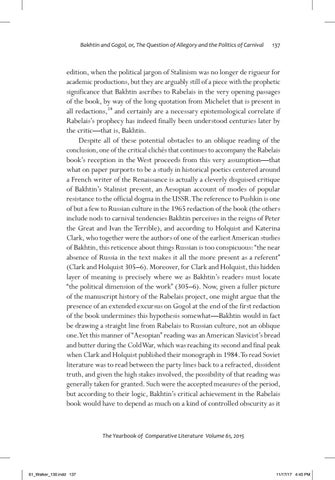Bakhtin and Gogol, or, The Question of Allegory and the Politics of Carnival
137
edition, when the political jargon of Stalinism was no longer de rigueur for academic productions, but they are arguably still of a piece with the prophetic significance that Bakhtin ascribes to Rabelais in the very opening passages of the book, by way of the long quotation from Michelet that is present in all redactions,14 and certainly are a necessary epistemological correlate if Rabelais’s prophecy has indeed finally been understood centuries later by the critic—that is, Bakhtin. Despite all of these potential obstacles to an oblique reading of the conclusion, one of the critical clichés that continues to accompany the Rabelais book’s reception in the West proceeds from this very assumption—that what on paper purports to be a study in historical poetics centered around a French writer of the Renaissance is actually a cleverly disguised critique of Bakhtin’s Stalinist present, an Aesopian account of modes of popular resistance to the official dogma in the USSR.The reference to Pushkin is one of but a few to Russian culture in the 1965 redaction of the book (the others include nods to carnival tendencies Bakhtin perceives in the reigns of Peter the Great and Ivan the Terrible), and according to Holquist and Katerina Clark, who together were the authors of one of the earliest American studies of Bakhtin, this reticence about things Russian is too conspicuous: “the near absence of Russia in the text makes it all the more present as a referent” (Clark and Holquist 305–6). Moreover, for Clark and Holquist, this hidden layer of meaning is precisely where we as Bakhtin’s readers must locate “the political dimension of the work” (305–6). Now, given a fuller picture of the manuscript history of the Rabelais project, one might argue that the presence of an extended excursus on Gogol at the end of the first redaction of the book undermines this hypothesis somewhat—Bakhtin would in fact be drawing a straight line from Rabelais to Russian culture, not an oblique one.Yet this manner of “Aesopian” reading was an American Slavicist’s bread and butter during the Cold War, which was reaching its second and final peak when Clark and Holquist published their monograph in 1984.To read Soviet literature was to read between the party lines back to a refracted, dissident truth, and given the high stakes involved, the possibility of that reading was generally taken for granted. Such were the accepted measures of the period, but according to their logic, Bakhtin’s critical achievement in the Rabelais book would have to depend as much on a kind of controlled obscurity as it
The Yearbook of Comparative Literature Volume 61, 2015
61_Walker_130.indd 137
11/17/17 4:45 PM
